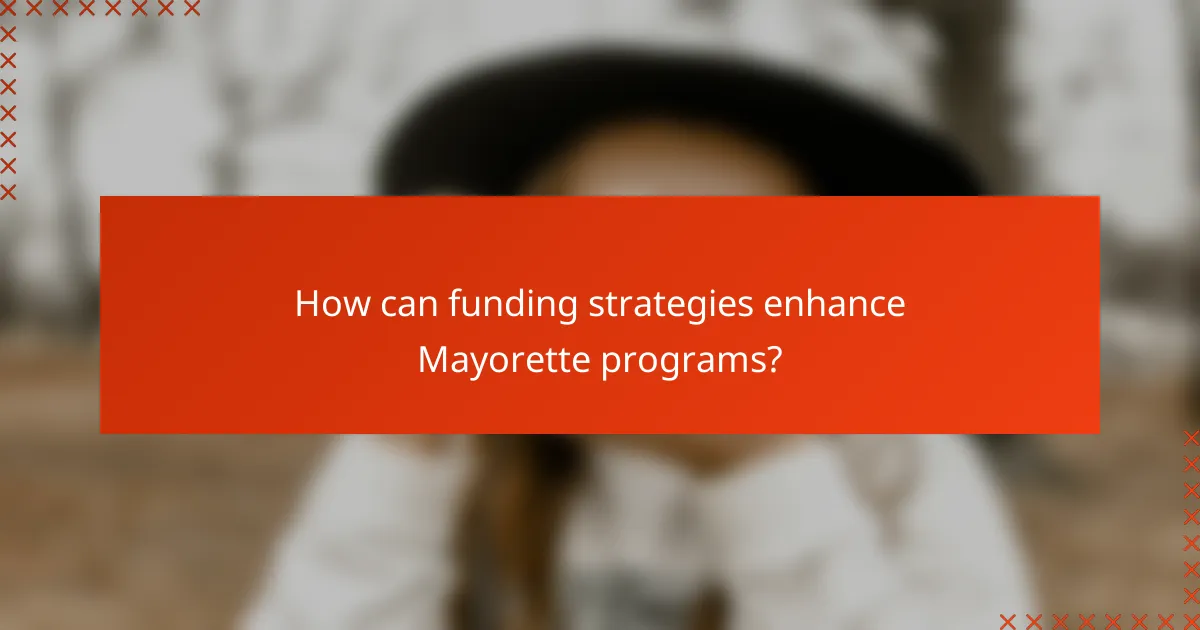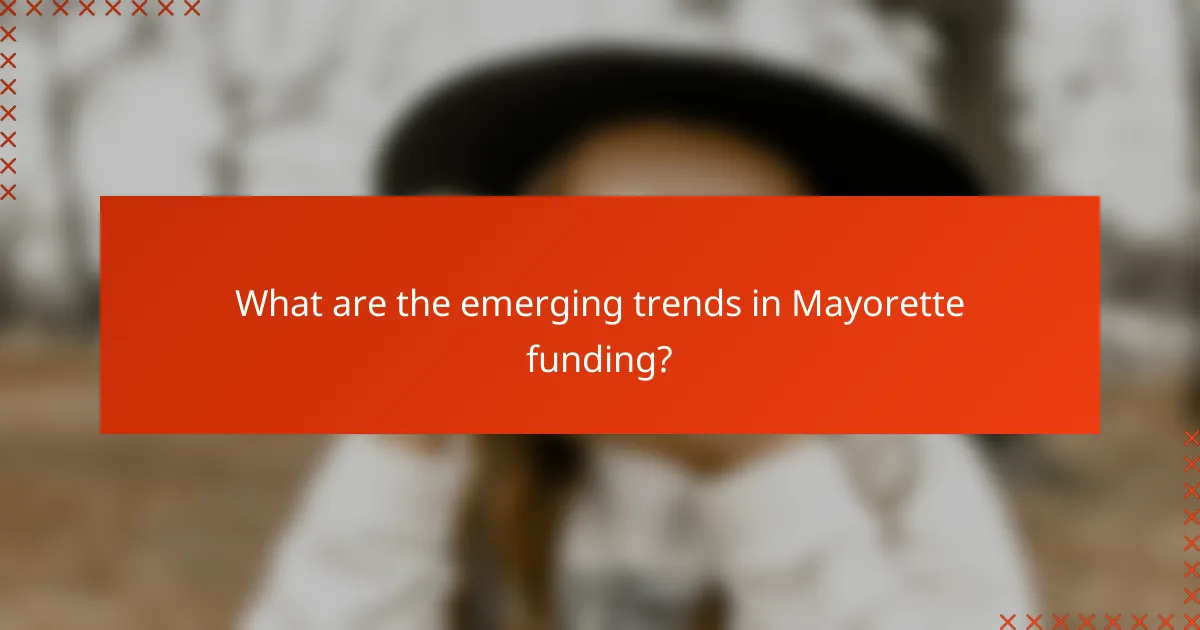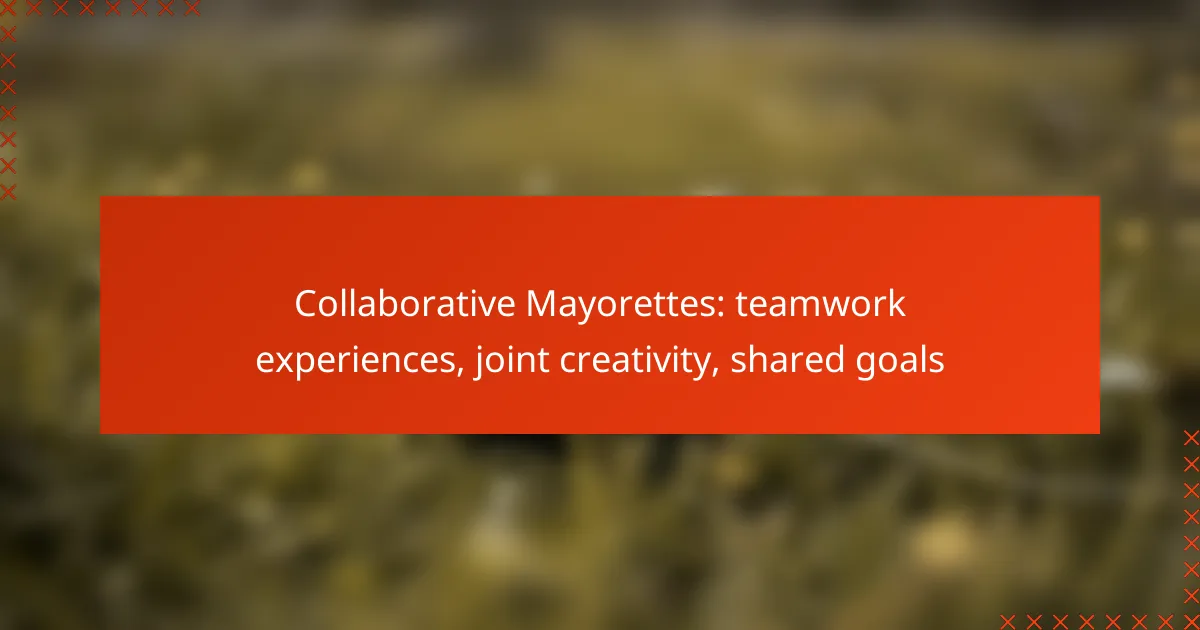Budget Mayorettes in Canada can thrive by implementing cost-effective strategies that utilize community resources and partnerships, ensuring efficient operations while maximizing their impact. By adopting diverse funding strategies, these programs can secure long-term sustainability and enhance their ability to serve the community. Additionally, effective resource allocation focuses on prioritizing initiatives that engage residents and leverage volunteer efforts, ultimately fostering a more vibrant and connected community.

What are cost-effective options for Mayorettes in Canada?
Cost-effective options for Mayorettes in Canada include various strategies that leverage community resources and partnerships to minimize expenses while maximizing impact. These options can help ensure that Mayorettes operate efficiently and sustainably, allowing them to focus on their core activities.
Community sponsorship programs
Community sponsorship programs involve local organizations or individuals providing financial or material support to Mayorettes. This can include donations of money, supplies, or services that help reduce operational costs. Establishing clear sponsorship tiers can encourage more businesses and individuals to contribute.
To attract sponsors, Mayorettes should highlight the benefits of sponsorship, such as visibility in community events or promotional materials. Regular communication and recognition of sponsors can strengthen these relationships.
Local business partnerships
Forming partnerships with local businesses can provide Mayorettes with essential resources and support. Businesses may offer discounts, services, or even monetary contributions in exchange for advertising opportunities or community goodwill. This symbiotic relationship can enhance the visibility of both parties.
When approaching local businesses, it’s beneficial to present a clear value proposition that outlines how the partnership can benefit them, such as increased foot traffic or positive community engagement.
Grants from municipal governments
Municipal governments often provide grants to support community initiatives, including Mayorettes. These grants can cover various expenses, from operational costs to specific projects. Researching available grants and understanding the application process is crucial for securing funding.
Mayorettes should prepare a compelling proposal that aligns with the municipality’s goals and demonstrates the potential impact of their activities. Keeping track of deadlines and required documentation is essential for successful applications.
Fundraising events
Organizing fundraising events is a direct way for Mayorettes to generate income while engaging the community. Events can range from bake sales and car washes to larger activities like charity runs or auctions. Successful events often rely on community participation and support.
To maximize fundraising potential, Mayorettes should plan events that appeal to their target audience and promote them effectively through social media and local networks. Setting clear fundraising goals can help measure success and motivate participants.
Volunteer-based initiatives
Utilizing volunteers can significantly reduce operational costs for Mayorettes. Volunteers can assist with various tasks, from event planning to administrative duties, allowing the organization to allocate funds more effectively. Creating a strong volunteer program can enhance community involvement and support.
To attract and retain volunteers, Mayorettes should provide clear roles, training, and recognition for their contributions. Regular engagement and feedback can help maintain volunteer enthusiasm and commitment.

How can funding strategies enhance Mayorette programs?
Funding strategies can significantly improve Mayorette programs by providing diverse financial support and ensuring long-term sustainability. Effective funding allows for better resource allocation, enabling programs to thrive and serve their communities more effectively.
Diversified funding sources
Diversifying funding sources is crucial for the stability of Mayorette programs. Relying on a single source, such as government grants, can be risky; if that funding is cut, the program may struggle. Consider exploring a mix of local business sponsorships, community fundraising events, and grants from non-profit organizations.
Engaging with multiple funding sources can also enhance community involvement and support. For instance, local businesses may contribute not only financially but also through in-kind donations, such as supplies or services, which can further reduce costs.
Budgeting for sustainability
Budgeting for sustainability involves planning finances to ensure long-term viability of Mayorette programs. This means creating a budget that accounts for both immediate needs and future growth. Aim for a balanced budget that includes operational costs, program development, and emergency funds.
Regularly reviewing and adjusting the budget based on actual expenditures and income can help maintain financial health. Establishing clear financial goals and tracking progress against them can guide decision-making and resource allocation effectively.
Leveraging crowdfunding platforms
Crowdfunding platforms can be a powerful tool for raising funds for Mayorette programs. These platforms allow individuals and organizations to contribute small amounts of money, which can add up to significant support. Popular platforms like GoFundMe or Kickstarter can help reach a wider audience beyond local communities.
When using crowdfunding, it’s essential to create a compelling campaign that clearly outlines the program’s goals and needs. Engaging storytelling and transparent budgeting can motivate potential donors to contribute. Additionally, promoting the campaign through social media can enhance visibility and encourage participation.

What are effective resource allocation strategies for Mayorettes?
Effective resource allocation strategies for Mayorettes focus on maximizing community impact while minimizing costs. This involves prioritizing initiatives that engage residents, leveraging volunteer efforts, and utilizing technology for efficient management.
Prioritizing community engagement
Community engagement is crucial for Mayorettes as it fosters trust and collaboration. Prioritize initiatives that directly involve residents, such as local events or feedback sessions, to ensure that resources are directed toward what the community values most.
Consider implementing regular surveys or town hall meetings to gauge community interests and needs. This approach not only enhances participation but also helps in allocating funds to projects that will have the greatest impact.
Optimizing volunteer resources
Volunteers are a vital resource for Mayorettes, offering support without significant costs. To optimize this resource, establish clear roles and responsibilities that match volunteers’ skills and interests, ensuring they feel valued and engaged.
Provide training sessions to equip volunteers with necessary skills, which can enhance their effectiveness and retention. Additionally, consider creating a volunteer recognition program to acknowledge their contributions, which can motivate ongoing participation.
Utilizing digital tools for management
Digital tools can streamline operations and improve resource allocation for Mayorettes. Use project management software to track tasks, deadlines, and budgets, which can enhance transparency and accountability.
Social media platforms can also be leveraged to communicate with the community, share updates, and gather feedback quickly. Additionally, consider using online donation platforms to facilitate fundraising efforts, making it easier for residents to contribute financially to community projects.

What criteria should be considered for selecting funding options?
When selecting funding options for budget mayorettes, it’s essential to evaluate criteria such as alignment with community goals, availability of matching funds, and the long-term viability of the funding sources. These factors ensure that the funding not only meets immediate needs but also supports sustainable growth and community development.
Alignment with community goals
Funding options should directly support the objectives and priorities of the community. This alignment ensures that resources are utilized effectively and that the projects funded resonate with the needs and desires of local residents. For example, if a community prioritizes environmental sustainability, funding should be directed towards green initiatives.
Consider engaging with community stakeholders to gather input on their goals. This can help identify which funding sources will be most beneficial and relevant. Regular assessments of community needs can also guide future funding decisions.
Availability of matching funds
Matching funds can significantly enhance the viability of a project by leveraging additional resources. Many funding sources, such as government grants or private foundations, require a certain percentage of matching funds from local sources. Understanding these requirements is crucial for securing funding.
Explore local businesses, non-profits, and community organizations that may be willing to contribute matching funds. This collaboration not only strengthens community ties but also increases the overall funding pool available for projects.
Long-term viability of funding
Assessing the long-term viability of funding options is critical to ensure that projects can be sustained beyond initial funding periods. Look for sources that provide ongoing support or have a track record of stability. This can include government programs, established foundations, or community endowments.
Consider the implications of relying on temporary funding sources. Projects funded by one-time grants may face challenges in maintaining operations once the funding ends. Developing a diversified funding strategy can help mitigate these risks and ensure continuous support for community initiatives.

What are the emerging trends in Mayorette funding?
Emerging trends in Mayorette funding focus on innovative financing methods, sustainability, and community engagement. These trends reflect a shift towards more responsible and inclusive funding strategies that prioritize long-term benefits over short-term gains.
Increased focus on sustainability
The trend towards sustainability in Mayorette funding emphasizes environmentally friendly practices and resource-efficient strategies. This includes prioritizing projects that reduce carbon footprints and promote renewable energy sources.
Funding for sustainable initiatives often comes from grants, public-private partnerships, and community-driven campaigns. For example, local governments may allocate a portion of their budgets to support green infrastructure projects, such as energy-efficient buildings or sustainable transportation systems.
When considering sustainability, it’s crucial to evaluate the long-term cost savings versus initial investments. Engaging with community stakeholders can help identify the most impactful projects and secure necessary funding through collective efforts.



